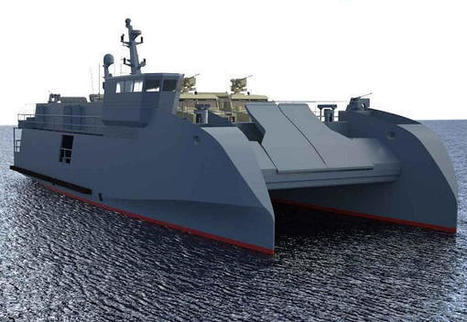La società francese Cnim ha presentato ai media il mezzo da sbarco “Lcat Mk2”
La guerra anfibia si sta evolvendo verso ambienti più controversi e così sono le piattaforme utilizzate per supportare tali operazioni. Durante l'Euronaval Online, la CNIM ha sollevato il velo su di una variante più veloce, più protetta e armata del suo noto mezzo da sbarco catamarano LCAT, la Mk2; questa versione migliorata è rinforzata su di un certo numero di punti.
Il powerpack è del 20% più potente di quello installato nel LCAT Mk1 ed è composto da quattro motori MTU da 1340 kw. Le dinamiche dell’unità da sbarco sono migliorate anche dall'aggiunta di un secondo foil a prua che permette, con l'aumento della potenza, di aumentare notevolmente la velocità, passando da 18 nodi a 25 nodi a pieno carico, e da 30 nodi a 35 nodi a vuoto.
L'LCAT Mk2 ha una migliore protezione e nuovi sistemi di armamento con due sistemi d'arma telecomandati da 20 mm situati a prua e due mitragliatrici da 12,7 mm a poppa, contro un mix di 12,7 mm e 7,62 mm con la versione Mk1. La timoneria è stata ampliata e blindata per proteggere l'equipaggio da potenziali attacchi quando la nave si avvicina all'area di attracco.
Con l'evoluzione Mk2, la CNIM si rivolge chiaramente al mercato delle esportazioni in quanto la Francia non prevede un programma di aggiornamento per i quattro EDA-R commissionati dalla Marina francese tra il 2011 e il 2012. Diversi clienti stranieri sono ora interessati a navi anfibie veloci.
Il LCAT Mk2 permette di posizionarlo definitivamente come concorrente diretto dell'LCAC americano per le marine interessate alle operazioni anfibie ad alta velocità. È ancora riservato a poche marine alleate o amiche, ma è paragonabile in velocità ad un LCAC ma con semplicità di utilizzo e costi di manutenzione molto più contenuti.
Caratteristiche tecniche del LCAT Mk2:
- Lunghezza / Larghezza: 30 m / 12 m
- Immersione a pieno carico: 1 m
- Velocità a pieno carico / vuoto: 25/35 kts
- Carico utile normale / massimo: 80/100 t
- Superficie della piattaforma: 127 m2
- Stato del mare: fino a 5
- Armi: 2 x 20 mm RCWS + 2 x 12,7 mm.
ENGLISH
French company Cnim presented the "Lcat Mk2" landing craft to the media
Amphibious warfare is evolving towards more controversial environments and so are the platforms used to support such operations. During Euronaval Online, CNIM lifted the veil on a faster, more protected and armed variant of its well-known LCAT catamaran landing craft, the Mk2; this improved version is reinforced on a number of points.
The powerpack is 20% more powerful than the one installed in the LCAT Mk1 and consists of four 1340 kw MTU engines. The dynamics of the landing unit are also improved by the addition of a second foil at the bow which allows, as power increases, to increase speed considerably, from 18 knots to 25 knots at full load, and from 30 knots to 35 knots at no load.
The LCAT Mk2 has improved protection and new armament systems with two 20 mm remote-controlled weapon systems located forward and two 12.7 mm machine guns aft, against a mix of 12.7 mm and 7.62 mm with the Mk1 version. The wheelhouse has been expanded and armoured to protect the crew from potential attacks when the ship approaches the docking area.
With the Mk2 evolution, CNIM is clearly targeting the export market as France does not foresee an upgrade programme for the four EDA-Rs commissioned by the French Navy between 2011 and 2012. Several foreign customers are now interested in fast amphibious vessels.
The LCAT Mk2 allows it to be definitively positioned as a direct competitor to the US LCAC for marinas interested in high-speed amphibious operations. It is still reserved to a few allied or friendly navies, but it is comparable in speed to an LCAC but with ease of use and much lower maintenance costs.
Technical characteristics of the LCAT Mk2:
- Length / Width: 30 m / 12 m
- Diving at full load: 1 m
- Speed at full load / empty: 25/35 kts
- Normal / maximum payload: 80/100 t
- Platform surface area: 127 m2
- Sea state: up to 5
- Weapons: 2 x 20 mm RCWS + 2 x 12.7 mm.
(Web, Google, Wikipedia, Navalnews, You Tube)


















Nessun commento:
Posta un commento
Nota. Solo i membri di questo blog possono postare un commento.